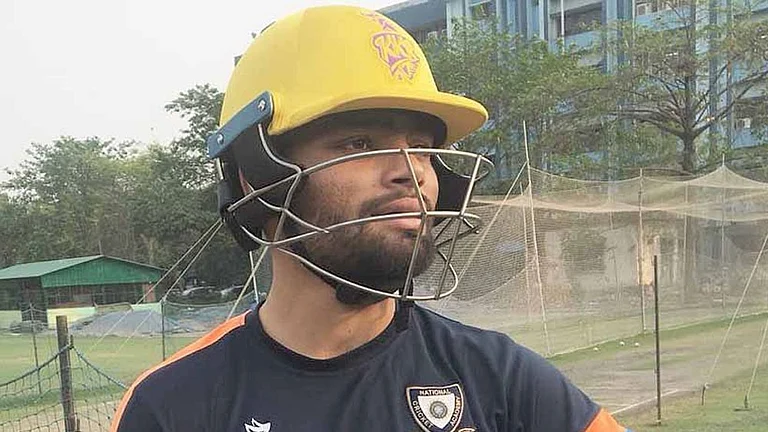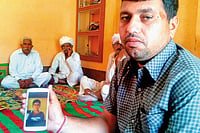Korobi Basumatary, a Bodo activist of the Rashtra Sevika Samiti, began to expand her network days after becoming a pracharika, or full-timer, in 2008. I’d first met her on a December afternoon in 2012 at a Rashtra Sevika Samiti camp in Aurangabad, Maharashtra, to which she had travelled all the way from Kokrajhar. Picked up at an impressionable 20 years of age from a relief camp in 2004, after her house was destroyed and her family scattered in Bodo-Muslim violence, she had committed herself to the Hindutva ideology. It was Sunita, a seasoned pracharika from Maharashtra who had been working in the Northeast for over two decades since the Nellie massacare, who spotted her and took her to a kishori varg, or training camp for young women. Of the passage from trainee to full-timer, or pracharika, Korobi had then told me: “It was like control of destiny—in my hands.”
A pracharika holds a prestigious position in the Hindutva scheme of things. They are well trained in the ideology, as also in paramilitary skills. Like the pracharaks of the Rashtriya Swayamsevak Sangh, they practise celibacy. The renunciation of the materialistic and sexual aspects of life grants them a special status, the chastity being associated with purity and spirituality. Pracharikas commit themselves for life to work in remote areas, spreading the Sangh parivar’s Hindutva ideology.
“As a Sevika Samiti pracharika, I’ve learnt how to fight for my rights and take what is mine,” I remember her telling me at the camp, her face flushed with blood, the fixation on “revenge” seeming absolute.
Four years on, Korobi, now 32, has been identified by the ASCPCR as one of the main executers—along with Sandhyaben Tikde—who organised the trafficking of the 31 children. Her successful implementation of the Hindutva agenda on the ground is proof of how the Sangh parivar is making a determined play for young girls in the conflict zones of the Northeast, tailoring its siren calls to their vulnerabilities, frustrations and ambitions, and filling the void the State has so far failed to address. Besides, the frequent spurts of inter-ethnic violence in the region have helped their efforts.
As we wait outside Divi Basumatary’s locked house in Malgaon village in Kokrajhar, an irritated voice is heard. “Now who are you? What do you want?” It’s Ropi, thirty-something, slim and athletic, walking up with two buckets of water in her hands and her year-old daughter Arunika sling-tied to her back. I tell her we have come to ask about Divi, her five-year-old daughter—one of the 31 missing children.
“First you took her away, and then all her pictures,” she retorts. “When will she come back?”
“Who took away her pictures?”
“Someone like you,” she says. “I’d called Korobi to ask about Divi; she sent someone who took both pictures I had of her.”
“Don’t you have another copy?”
“This village is 40 km from the nearest town,” says Ropi, visibly upset. “We don’t have so many pictures like you people.”
Putting the buckets in a corner, she opens the locked hut. She picks up a stool next to the handloom inside, on which an orange dokhana—a traditional Bodo wraparound for women—is in the process of being woven. Ropi earns from making dokhanas and selling them in the city, while her husband Bakul Basumatary works in a cable factory in Guwahati and visits her every six months.
Bakul is upset with Ropi for having sent Divi away in his absence. “He says we have lost her because of me,” she tells me. Korobi had told her Divi would study in a school and visit her every year. “But it’s been a year since we even spoke to her. Korobi now says Divi will come after three or four years. She has even stopped answering my phone,” says Ropi, breaking down.
Like Ropi, none of the 31 parents have a single official document to prove they handed over their daughters to the Rashtra Sevika Samiti, Vidya Bharati or any communication with the ‘schools’ the children are supposed to be in. With the pictures taken away and no further communication with their handlers, it is difficult for them to launch a search.
“But what made you send your daughter away?” I ask.
“Sewa Bharati,” she replies.
***
In the border areas of Assam, there’s a comprehensive network of Sangh outfits such as Sewa Bharati, which concentrate on welfare activities—medical camps, activity camps and so on. Vidya Bharati and Ekal Vidyalaya concentrate on providing Hindu nationalistic education to children. The Vanvasi Kalyan Ashram and Friends of Tribal Society look into the ‘welfare’ of tribals. The pracharikas make use of these outfits to reach remote areas to spread the Sangh parivar’s Hindutva idealogy.
Sewa Bharati was set up in 1978 by Balasaheb Deoras, the third RSS sarsanghchalak, to focus on marginalised sections of society. The Akhil Bharatiya sahaseva pramukh, or all-India ancillary services chief of the RSS, guides the organisation and it is represented in the Akhil Bharatiya Pratinidhi Sabha, the highest decision-making body of the RSS. That way, Sewa Bharati has an influential place in the array of Sangh parivar outfits. According to the Sewa Bharati website, they run over 1.5 lakh welfare projects in India. They also run hostels for young tribal girls and boys and informal education centres in India.
***
“We had all fallen ill two years back—Divi, my two other children, and me,” says Ropi. “Kanchai, of Sewa Bharati, had organised a medical camp. That’s when we got in touch.”
After the camp wound up, Kanchai started a matrimandli, or committee of mothers, that would meet every week. “We’d sing songs, and Kanchai discussed things like hygiene with us—how to use the toilet, how to make pads at home for use during periods. She was a Bodo, and so it was good to have someone who knew our language and culture telling us all this.”
Simultaneously, Kanchai organised a bal shivir, a three-day camp to teach children ‘sanskaar’ and the importance of becoming good citizens. “That’s when Kanchai asked me to meet Korobi and send Divi to school in Gujarat.”
This is the usual strategy for penetration used by the Sangh. First, the welfare organisations step in. They increase the mass base, identify potential trainees. Small steps like visiting the remotest village, distributing lockets, pamphlets and Hindu literature pave the way for complete penetration. Then, the local Rashtra Sevika Samiti and RSS full-timers follow. The services of Sewa Bharati come especially handy in areas where the State has failed to provide basic amenities to its people. Sewa Bharati acts as a safe front for these activities. Most villagers and parents think that the children have been taken away for education by the NGO Sewa Bharati. The Sangh connection and Hindutva indoctrination is less apparent to a rural person.

Brahma helped the Sangh parivar zero in on needy families
Living and growing up in the conflict areas of Assam rife with incessant Bodo-Muslim or Bodo-adivasi ethnic violence makes people feel strongly about their identity and stick by their own. The possibility of differentiating between right and wrong becomes minuscule. Paranoia takes over, paving the way for Hindutva propaganda.
***
Kanchai Brahma is a 34-year-old activist of Sewa Bharati in Gossaigaon, a small town in Kokrajhar district. Her story has many parallels with that of both Korobi and the 31 girls in question. At age 15, she participated in a kishori varg camp organised by Sewa Bharati in her village Kumursami. “These camps primarily focus on teaching sanskaar to young girls,” she tells me as she clicks my picture in her office.
“What kind of sanskaar?” I ask.
“Girls are told how they have forgotten their culture, where a ‘hello’ has replaced ‘namaskar’ and long pants have taken the place of our traditional dress. All this is because of the influence of Christian lifestyle. They should get back to their culture and become good women of the nation,” she says with a smile.
With such training, the young women grow up with an unquestioning belief in the Hindutva idea of the intended role of women in the Hindu rashtra, as the Outlook article (Jan 28, 2013) on the Aurangabad camp showed. They focus on celebration of folklore, language and history, teaching an anti-Muslim, anti-Christian interpretation of these. Among the Bodos, there’s no scepticism about the Sewa Bharati’s activities because of the stellar reputation women like Kanchai and Korobi, who are from the same community, command and the image of empowerment they project. This girl-power tactic has proved adept at appealing to the parents of small girls who have ambition for their children but no means. It works like a girl-to-girl recruitment strategy.
Kanchai was spotted by a Rashtra Sevika Samiti pracharika at a camp in 2003. In 2004, she was sent off to a hostel in Uttar Pradesh for training, along with three other girls from her district. After a year’s training, she came back in 2005. “In the next two years, we canvassed in three districts—Goalpara, Kokrajhar and Chirang—and told them about the excellent time we had and managed to send 500 girls to that hostel,” says Kanchai. “Over the years, some of them returned and got married. They now work as grahini sevikas, or part-timers.”

Kanchai, of Sewa Bharati
Parents who are not part of Sewa Bharati’s cult activities are treated differently, and the others inform Sangh workers if they were not acting in line. Her conviction evident, Kanchai says, “Bodo people are being fooled by Christians, killed by Muslims. I was trained to save their identity and remind them of their Hindu origins. Since I am a Bodo myself, I joined Sewa Bharati and started working towards the development of Bharat Mata.”
As Kanchai scouts for recruits, a recent addition to her efforts comes from the Sangh parivar’s Ekal Vidyalaya project and the Van Bandhu Parishad. Ekal Vidyalayas are one-teacher schools, essentially non-formal education centres where one teacher takes up to 40 students for three-hour sessions. “They are taught national songs, poems, games. Instead of ‘Ba ba black sheep, have you any wool?’ we teach them ‘Bharat desh, mera desh, meri mata aur pranesh, meri jaan, mere praan, Bharat mata ko qurbaan,” she says.
There’s a focus on choral singing, which fosters a sense of unity, conformity and group identity. Children are taught folk songs, presenting Indian history in line with Hindutva ideology. The girls sing at many festivals and occasions organised by Sewa Bharati, such as medical camps and matri mandalis, and also for public entertainment at special events. It’s a quiet, subtle indoctrination.
The Ekal Vidyalaya Foundation was registered in 2000, though the schools have been functional since 1986. As of 2013, it had a presence in close to 52,000 villages in the tribal belts of India. It is associated with the Vishwa Hindu Parishad, a Sangh parivar outfit. In the past, it was headed by Subhash Chandra of Zee News. BJP MP Hema Malini has served as its brand ambassador. According to Phoolendra Dutta, the RSS activist from Kokrajhar, there are over 290 Ekal Vidyalayas in Kokrajhar district alone. The Van Bandhu Parishad helps Ekal Vidyalayas devise a methodology to provide “education with sanskaar to the vanyatries (tribals)”. They support and enhance the curriculum taught in schools: lessons are moulded around the Hindutva understanding of history, biology and geography. The teaching is geared to produce religion-conscious, obedient, self-sacrificing Hindutvavadis. Sewa Bharati, through its kishori and bal vargs, helps in enrolling children in these schools, quietly creating a culture of moral policing and threatening the natural diversity of faith and practices.
“Training girls is most important because they can inculcate values in the entire community in a way that will take years to be corrupted,” says Kanchai. “They can raise families that will be the core of a Hindu rashtra. That is why we especially pay attention to counsel young girls not to use cellphones.”
“How?” I ask, hoping for a different logic from that offered by the khaps of north India in their attempt to rein in young women’s sexuality.
“There is a rule in Hindu religion that one has to marry within our religion,” says Kanchai. “Young girls talk to boys on the phone and then elope to get married. We recently struggled to get a girl to leave the Muslim man she had married. Initially, she refused because she was pregnant but after repeated guidance by us, she left him. We told her how the Muslims had killed Bodo people in the neighbouring villages. She saw reason. She has now separated from her husband and works for Sewa Bharati.”
Both Kanchai and Korobi have turned out to be effective recruiters of young girls for the Sangh outfits. Their insider image in the Bodo community is a strategic plus point. As women, they tend to gain the trust of the local community more easily than men might. The positive representation of their own image and experience at the training camps outside Assam is not only persuasive but also one that young women might aspire for. This inculcates an unquestioning understanding of the role of women as mothers, wives, daughters and radicalises them in the cause of a Hindu rashtra.
Four years after meeting Korobi in the Aurangabad training camp, her phone call to me in the house of one of the missing children’s parents made me notice the change in tenor. That time, she had been firm and polite. Now, she was defensive and rash.
I was in Ghana Kanta Brahma’s house in Daodshri village in Kokrajhar. He had also sent his daughter, Bhumika Brahma, to Gujarat. His house is massive, perhaps one of the largest in the village. As I sat in the courtyard, admiring the wall arts and murals around it, his wife Subhadra brought tambul—betel leaves and areca nut—to welcome me in traditional Assamese fashion.
I was cross-checking the details of the affidavit he had signed to hand over his daughter. Parents of three girls had told me that Brahma had worked as a BJP mobiliser in the recently concluded Assam elections. He had helped Korobi identify these three girls to be sent along with his daughter, just like Mangal Mardi had. Says Dena Tudu, Sukurmani’s father, “He (Brahma) speaks to his daughter almost every day. But we don’t know where he has sent our daughters. He is rich but are poor people meant to give away their children in charity?”
When I ask Brahma why he said in his affidavit that he had no source of income though he owns 20 bighas, he brazens it out with a “Just like that.”
“Meaning?”
“Meaning that instead of letting the Muslims and Christians convert people of our community and take away all our land and jobs, I am saving the children with the help of Korobi and RSS and restoring other Bodos to their original identity,” he says.
Sangh workers like Korobi have mastered the art of manipulation. In a conflict-torn area, they work to turn the slightest bit of hearsay into fact, raising suspicions and creating paranoia and anger so that people are unable to think through things clearly. All this serves their agenda. It runs parallel to the Sangh parivar’s ghar wapasi programmes elsewhere. The germinal idea is the same: as the Sangh declares so facilely, all Dalits, tribals and Muslims in India are originally Hindu. When Sangh outfits announced ghar wapasi programmes, pushing through a series of reconversions of Muslims and Buddhists to Hinduism in 2014, an Akhil Bharatiya Vanvasi Kalyan Ashram report stated: “Out of 10 crore tribal population of the country, 1.22 crore have converted to Christianity. The Ashram has approached 53,000 villages and wants to reach out to the remaining 1.09 lakh tribal village by 2015 end.”
I try to confront Brahma to seek a reaction to the dubious practice vis-a-vis children, and ask him, “But why make false documents and lie to other parents? This is illegal.” In response, he animatedly says something in Bodo, which I don’t understand, and takes my picture on his giant-sized smartphone. Before I can make sense of it all, he dials a number and shoves the phone in my hand.
“Hello,” I say.
“Why are you people constantly coming and interrogating these parents? Where were you when the Muslims were ruthlessly killing these people?” shot a voice from the other side in Sanskritised Hindi.
“Who are you? Please introduce yourself,” I request her.
“My name is Korobi. I am not scared of you guys. Go and tell whoever you want, OK?” she says.
“Why don’t you meet me and talk to me about it?” I say.
“I don’t want to meet anyone. You people don’t care about Hindus at all. Hindus, who are the real inhabitants of this country. You are only worried about outsiders like Muslim Bangladeshis. And now you are even spreading rumours about the RSS trafficking children,” she says.
Clearly, she is aware of the official proceedings and police complaints against her and others.
“I never mentioned the RSS or any other organisation. In fact, it is you who is saying it,” I reply.
“When Muslims come and take their jobs, their land, rape their women, then it is the RSS that comes and helps them and not you guys from Delhi,” she continues.
“I am just asking about the whereabouts of the girls. If you have to say anything, please meet me. This way you are disrupting my work,” I say.
“I don’t want to say anything. Just stop talking to the parents. Go to our office in Jhandewalan in Delhi and ask them all these questions.”
She hangs up.
***
Read More
Part 1: Baby Snatching
Part 3: Ranis Of Chhota Kashi
Part 4: ‘Those Nimn Jaati Girls’
Part 5: Ghar Wapasi For The Girls?


























